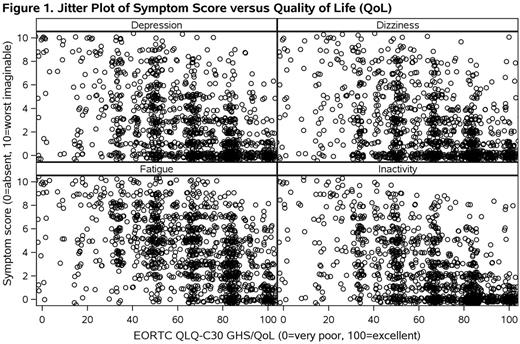Abstract
Background: Patients with myeloproliferative neoplasms (MPNs) are faced with high disease-related symptom burden and quality of life (QoL) decrements. Emanuel et al. (J Clin Onc, 2012) previously showed that symptom burden as measured by the MPN Symptom Assessment Form (MPN-SAF) Total Symptom Score, which is computed as the sum of the 10 most clinically important MPN-SAF symptoms, strongly correlated with QoL (Pearson r=.51; P <.001) as measured by the Global Health Status/QoL (GHS/QoL) scale of the European Organization for Research and Treatment of Cancer Quality of Life Questionnaire Core 30 (EORTC QLQ-C30). However, a systematic analysis of predictors of QoL in this cohort has not previously been undertaken. The purpose of this analysis is to assess which of the 18 individual symptoms from the MPN-SAF or summary measures across the symptoms are associated with QoL.
Methods: This secondary analysis was conducted using data from a previously enrolled cohort of patients with MPNs who completed a symptom assessment packet (MPN-SAF and the EORTC QLQ-C30) at a single clinic visit. Association between individual symptoms and QoL as assessed by the GHS/QoL scale of the EORTC QLQ-C30 was quantified using Pearson correlations. The following sets of summary measures were constructed: (1) presence of at least one symptom with a score of 1 or higher, presence of at least one symptom with a score of 2 or higher, and so on up to a score of 10; and (2) total number of symptoms with a score of 1 or higher, total number of symptoms with a score of 2 or higher, and so on up to a score of 10. These summary measures were investigated relative to QoL also using Pearson correlations. Pearson correlation coefficients were compared pairwise between sets of findings (individual symptoms and two summary symptom approaches) using Wilcoxon rank-sum tests.
Results:
Patient demographics and disease characteristics: Among 1422 patients with known disease type and who provided complete symptom/QoL data, disease type included ET (629, 44%), PV (457, 32%), and MF (336, 24%) with median age 59 years (range 15, 91) and 742 (52%) female.
Individual symptoms and QoL: The median correlation between individual symptoms and QoL was -.36 (range -.23, -.54, all P <.001). The strongest correlations (Figure 1) were observed for inactivity (-.54, P <.001), fatigue (-.48, P <.001), depression (-.48, P <.001) and dizziness (-.44, P <.001); the weakest were for fever (-.23, P <.001), cough (-.27, P <.001), night sweats (-.27, P <.001), and sexual desire/function (-.30, P <.001).
Summary symptom measures and QoL: The median correlation between QoL and presence of at least one symptom with a score at or above 1, 2, ..., 10 was -.36 (range -.20, -.40) which did not significantly differ from correlations based on individual symptoms (P=.80). The strongest correlations were observed for the presence of at least one symptom at or above a score of 6 (-.40, P <.001), a score of 7 (-.39, P <.001), and a score of 8 (-.38, P <.001); the weakest were for a score of 1 (-.20, P <.001), a score of 2 (-.27, P <.001), and a score of 10 (-.29, P <.001). The median correlation with QoL for the total number of symptoms at or above each score was -.52 (range -.33, -.56). The strongest correlations were observed for the total number of symptoms at or above a score of 3 (-.56, P <.001), a score of 2 (-.56, P <.001), and a score of 4 (-.55, P <.001); the weakest were for a score of 10 (-.33, P <.001), a score of 9 (-.43, P <.001), and a score of 8 (-.49, P <.001). The correlations for the total number of symptoms at or above each score were significantly stronger than those for individual symptoms (P <.001) and for presence of at least one symptom at or above each score (P <.001).
Conclusions: This study revealed that all individual symptoms correlate to some extent with QoL, with inactivity being most correlated. Summary measures in this analysis were intended to explore the impact of a single symptom above each score threshold or of multiple symptoms above each score threshold. The results suggest that having at least one severe symptom (i.e., presence of at least one symptom at or above a score of 6) and having multiple symptoms of moderate intensity (i.e., total number of symptoms at or above a score of 3) are meaningfully correlated with QoL decrements. The symptom burden experience is variable and undoubtedly bears heavily on quality of life among patients with MPNs as supported by these results.
Mesa: Promedico: Research Funding; Novartis Pharmaceuticals Corporation: Consultancy; Galena Biopharma, Inc.: Consultancy; Incyte Corporation: Research Funding; CTI BioPharma Corp.: Research Funding; Celgene Corporation: Research Funding; Gilead Sciences, Inc.: Research Funding; Ariad: Consultancy.
Author notes
Asterisk with author names denotes non-ASH members.


